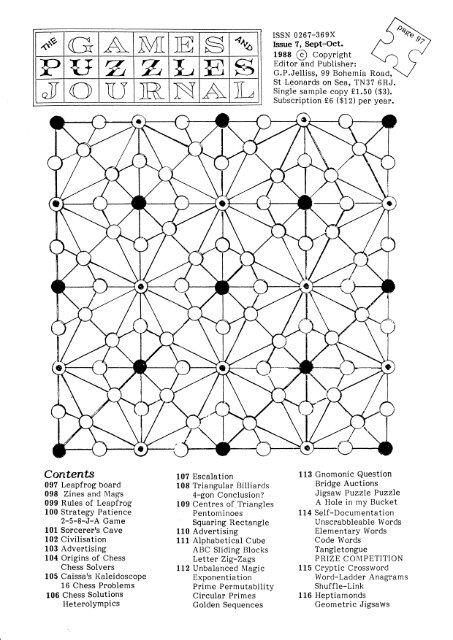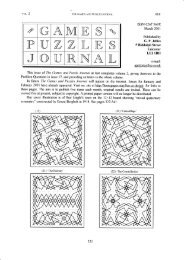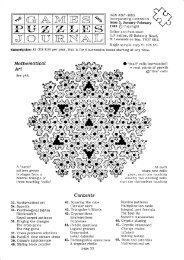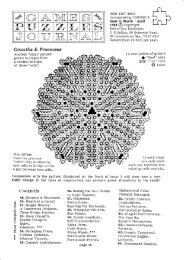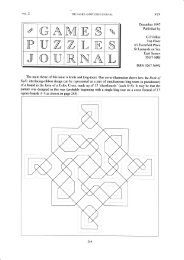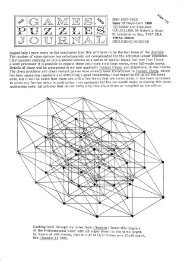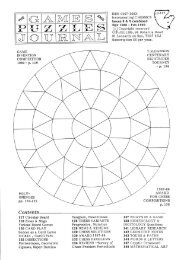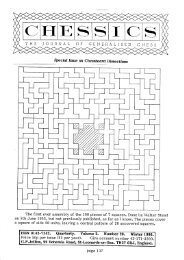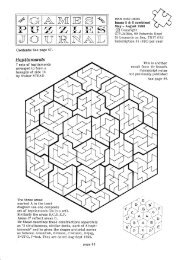The Games and Puzzles Journal, #7 - Mayhematics
The Games and Puzzles Journal, #7 - Mayhematics
The Games and Puzzles Journal, #7 - Mayhematics
Create successful ePaper yourself
Turn your PDF publications into a flip-book with our unique Google optimized e-Paper software.
THE GAMES A}{D PTJZZLES JOURNAI,LeoplrogThis game, published here for the first time, is played on a special board, illustratedon the front cover, on which it is possible to get from any point to any other by a seriesof tleapfrogr moves, that is straight leaps along the lines of the board over one interveningspot (which may or may not be occupied). If you try such a series of leaps on most otherboards employed for games you will find that there are some points that cannot be reachedfrom others.-For example, on a chessboard a leapfrog hopping along the ranks <strong>and</strong> files(i.e. a Dabbaba) can only reach a quarter of the squares - <strong>and</strong> it can do no better if itis allowed to leapfrog diagonally as weII. All the moves in Leapfrog are of this type.<strong>The</strong> obJect -of the game is to get your King Frog onto tfre central spot (or lily-pad)'where he becomes 'King of the Castlet - or should it be 'Potentate of the Pondr?<strong>The</strong> ordinary Frogs - dare I calt them Frog Pawns? - move.by hopping over onepoint to the nexf beyoncl, along a marked line on the board, regardless of whether theinteevening point is -vacant or occupied. <strong>The</strong> King Frogs however are too lumberingto be aUtJ tb get about unaided, so can only leap over occupied spots - the oecttpantcan be any other piece of any colour.At his turn to plav, a player may begin by moving any one o{ h.is Frogs any numberof leaps. <strong>The</strong> only ."rtri"tion is that no frog may return to a spot it has already occupiedor leapt over in that turn - in other wordi, no switchbacks or circuits - otherwise themove could go on neverendinglY.If the last of these leaps is over another Frog then that Frog is rtaggedt <strong>and</strong> mustitself be moved, if possible. This applies even if it is an opposition Frog - the turn toplay thus automatically passing to the opponent (in the multiplayer game this may resultin deviation from the otherwise cyclicrotation of the turn to play. <strong>The</strong> rtaggedr Frogmay move any number of leaps similarly, <strong>and</strong> if that one's last leap is over a Frog' thatone must be moved next. Thus it is conceivable that in some special positions a playermay be able to move all his Frogs in one turn of play.t 1---.- IY -/-n At the start of play each player has his King on one of the four'lily-pads' sumoundingthe centre, <strong>and</strong> his eight acolytes all round him. Thus there is a balanced opening positionfor two or four players, but a less balanced one for three players - one being betweenthe other two - which may or may not be a disadvantage.Two players may start with one team' each, <strong>and</strong> these may be placed on adJacentlily pads or on opposite lily pads; alternatively each player may control two teams,which may be placed adjacent to each other or opposite to each other - thus there arefour different opening positions to choose from in the two-player game.<strong>The</strong>re are no captures in Leap,frog, but there are tdisplacementst. <strong>The</strong> last Frogto move in any turn may make TGpiacements - in other words displacing forfeits th6right to tag another of one's own pieces. <strong>The</strong> attacking Frog must lelp over an occupiedspot on to an opposing Frog which is then displaced - one leap away in any direclionthe displacer chooses, provided only that the destination spot is vacant. <strong>The</strong> displacementmay be to the spot Just vacated by the displacer - so that the two pieces cnangeplaces. <strong>The</strong> attacking piece may make several displacements in one turn, -<strong>and</strong> may dGplaceanother piece several times. A tempting trick is to displace the 'opposing Kingto a spot where it is immobilised because it has no other Frog to leap over.page 99d,lrvE%.
"s-.rTHE GAMES AND PUZZLES JOURNALStrotery PotienceBy Philip M.COHENMy favourite patience (haven't played much lately) is from a book by GeoffreyMott-Smith <strong>and</strong> probably invented by him; I think it's called Strategy. Ultimate simplicity.Turn up cards one at a time <strong>and</strong> place each on any of six initially empty piles. I keepthe piles spread downwards so the game is pure strategy, with no remembering whatwent where. When all 52 cards are down, take cards from the tops of the piles, startingwith Aces, <strong>and</strong> build four piles up in suit to Kings. (In practice, one usually knpws alreadywhether or not this second stage is possible, but blockages - like putting S? on H5 <strong>and</strong>later H6 on 56 - can sometimes be missed.) tvtott-Smith recommends eight piles, butthat may be squared-off piles; without memorization involved, I almost never lose withseven piles, <strong>and</strong> I recall that I win 25-60% of the time with six, about 2% of. the timewith five' <strong>and</strong> twice in my life (on the way to a _.goal of five or more) with four. So thedifficulty is nicely parametrizable.Following up the above note: I find I have the statistics here from an orgy of play10-20 ye'ars ago. I played 727 games, considering it a loss if I had to go beyond 7 piles.<strong>The</strong> result was 584 wins (81.3%) at the ?-pile level, 213 (29,3%) at 6 piles, 22 (3.0vo) at5 piles, <strong>and</strong> 1 (0.1%) at 4 piles. Naturally, if I were playing for 6 piles I would take morechances <strong>and</strong> the number of wins at 5 <strong>and</strong> 4 piles would go up a little.2 - 6) - 8 - Jock- AceThis is a slightly modified version of another card game that was introduced intomy family circles by my youngest brother, from his days at sea. He learnt it under thename of tOn the DoIe' but I do not suppose this was the inventor's original name for it.Each player starts with four pennies (or higher denomingtions if you can afford it) <strong>and</strong>puts one of these into the central kitty. <strong>The</strong> loser in each round pays one coin into thekitty (or if there are two or more losers, each puts in one coin). When a player has nocoin left he is 'on the dole' <strong>and</strong> is allowed to play on until he loses again, when he hasto drop out - it may be that he can hold on to win. <strong>The</strong> winner takes all.For the first round each player receives seven cards (a usual 52 card pack is used)but in the next round only six cards each are deal.t, in the third round only five' <strong>and</strong> soon to the seventh round when each player receives only one. <strong>The</strong>reafter the number ofcards each receives increases one by one until in round 13 it is back to 7 again, <strong>and</strong> thecycle is repeated. <strong>The</strong> turn to deal rotates clockwise. <strong>The</strong> undealt cards are placed asa face-down pile in the centre, <strong>and</strong> the dealer turns up the top card, piacing it faceupalongside the .main pile.Play normally consists in either placing a card from your h<strong>and</strong> onto the face-upcard in the centre, to match it by rank or suit, or else taking the top card from theface-down pile to add to your h<strong>and</strong> - the turn then passing to the player to your leff.<strong>The</strong> round ends when one player gets rid of all cards from his h<strong>and</strong> (when each playerhas only one card a rroundr may consist of the placement of a single card). <strong>The</strong> loseris the player whose cards add to the highest total. Aces eount 20 for this purpose.<strong>The</strong> cards 2, 8, Jack, Abe however modify the play as follows:2 - forces the next player to ttake twor unless he can also play a 2, which forces hisneighbour in turn to ?take four' - <strong>and</strong> so on to 'take sixr <strong>and</strong> ttake eightt if atl the fourtwos come out together. 8 - instructs the next player to 'miss a go'. J - reverses thedirection of play to anticlockwise, so that your right-h<strong>and</strong> neighbour has the next go,<strong>and</strong> his right-h<strong>and</strong> neighbour follows, <strong>and</strong> so on, until another Jack is played (this canbe very giddying). A - is witd. It may be played on any other card, <strong>and</strong> may be nominatedto be of any suit - only cards of that suit may be played on to it. This is usefulfor getting out, but carries the danger of being caught with the 20 points.. Irve long thought that there ought to be a special use for the 5's also in this game,thus completing the arithmetical progression of special cards, but instead of puttingforward my own proposals for its special function lrve decided to put it out to tendei- in other words I would like to receive your suggestions for its best roie.page 100
THE GA.]I1IES'AND PUZZT,ES JOURNAI,Sorcererts CcveBy Stuart McINTYRE%,This game is a fairly old fantasy board game (it originally came outago!).x It is quite simple but also enJoyable <strong>and</strong> can be played solitaire. <strong>The</strong>about ten yearsmain advantageis that it has a short set-up time, but does require a lot of space.Basically, players lay out 'tiles' with various rooms, corridors, etc. on them as theymove about in the Sorcererrs Cave, so creating a different cave each time. In rooms,cards are taken showing the various monsters, treasures <strong>and</strong> events encountered in thecave. Some encounters can be profitable (some allies or treasure gained for the party)or not so profitable (traps, fights <strong>and</strong> so on). Usually the winner of the game is the playerwhose party escaped with the most treasure at the end, but other scenarios are suggested.A Lord of the Rir1gg one appealed to me, but the party with the ring were too weak torea@wheretheyhadtodisposeoftheRing,evenbeforethepartyofTrolls caught up with them!Because of the similarity, it is inevitable that Sorcerer's Cave will be comparedwith Dungeonquest by <strong>Games</strong> Workshop, which is also a fantasy game using tiles in thesame way (but the Dungeonquest tiles are a lot smaller than the ones in Sorcererrs paveso less room is required). I think Dungeonquest is the best game for experienced gamerstbut Sorcerer's Cave is better for novices or solo play (which is not very good in Dungeonquest),<strong>and</strong> is also about half the price.For those of you who have already got Sorcerer's Cave, here are some new rules.I was going to put new designs on the blank cards, but as there were only eight I thoughtof numbering them <strong>and</strong> allowing the cards to mean different things on different levels.Numbering them 1 to 8 I then use the appropriate table below to see what I find:LEVEL 7-21 u (H1-3, I4-5, F6) Three goblins52 each carrying one sack ofr<strong>and</strong>om treasure.2 Slime on floor: one party membertreads on it <strong>and</strong> droPs all heavYtreasure, which is dissolved.3 U (HL-4, 15-6) two orcs, 53 eachcarrying r<strong>and</strong>om item each.4 (Hf-G) Zombies: Any creaturepdrawn with this card, or next.AC Shield, saving throw L-2,6 C Bow <strong>and</strong> arrows: free attackat s2.7 C Magic platform: corrrm<strong>and</strong>edby wizard or priest, carries 100kgIC Hypnotic medallion: allowsthe party to roll all reactionstwice, taking best result.I,EVEL 3-4II (H1-4, I5-6) Three orcs, S3each one has a r<strong>and</strong>om item.(Ht -2, 14-6) Spider, 54, not seenif indifferent, else has freeattack.C Lightning conductor: freeattack at 54.C left-h<strong>and</strong> dagger: add one toS, but cannot use shield.C lVheelbarrow: doubles theusers carrying capacity,LEVEL 5+U (H1-5, 16) Hydra with 5 headseach (S3) must be killed" Guards3 sacks of gold.(H1-5, F6) Vampire, S5/Magic5,Discard non-human strangers,others are zombies.U (H1-3, 14-6) Poisonous snake: (H1*3, I4-5, FG) Salam<strong>and</strong>er, 56.after combat 50;50 chance.U (F1-6) Werewolf : appears man AC Ancient tomb: 4 skeletons, 54,but changes sides in next fight. guard armour (ZSt
THE GAMES AND PVZZLES JOURNAL^$-**'Crvrhsation.$95) A game that seeks to reconstruct the history of the world would seem to be theultimate ambition of the Simulationist branch of games philosophy - <strong>and</strong> this game seeksto do Just that - or at least, the history of the Eastern Mediterranean region rFrom theDawn of History to 250BCr, <strong>and</strong> succeeds quite well - though any such proJect is inevitablyopen to criticism for being neither didactically sound history nor tacticaliy pure game.<strong>The</strong> game was issued in September by H.P.Gibson & Sons Ltd, but appears to havebeen published previously in 1980 by a Northampton company. <strong>The</strong> designer, F.G.Tresham,is acknowledged, together with a test <strong>and</strong> developinent team. I note also that the gamewas tried oui for postal play in TROG (now ceased). It is currently on offer in Riqq4a<strong>Games</strong> Review.It would need care][flEbptation for this method of play.<strong>The</strong> boardr as produced by Gibsonrs, consists of four parts that fit together inthe fashion of a Jigsaw. <strong>The</strong>re are seven players (or fewer in special versions) <strong>and</strong> eachis provided with 50+ tokens, these are printed on thick card, ready to be pushed out.<strong>The</strong> rules of play, as might be expected, are extensive so only a sketch can begiven here. War-gaming is only a part of the strategy - 'the obJect of the game is togain a level of overall advancement involving cultural, economic <strong>and</strong> political factorsso that such conflicts as arise are due to rivalry <strong>and</strong> l<strong>and</strong> shortage'- the level of advancementis measured by accumulation of points. At the start each plaver has one tokenvalued at one point - representing a nomadic tribe. <strong>The</strong> tribes exp<strong>and</strong> into nations, formcities, accumulate trading commodities, <strong>and</strong> acquire arts, crafts, science <strong>and</strong> law.<strong>The</strong> materials traded in, the number of cards of each, <strong>and</strong> their individual valuesare as follows: Gold (3) 9, Gems (4) 8, Spice (5) ?, Bronze (6) 6, Cloth (7) 5, Grain (8) 4,Salt (9) 3, Iron (5) 2, Papyrus (5) 2, Hides (7) 1, Ochre (7) 1. In addition, among the tradecards, are 8 catastrophe cards: Piracy, Iconoclasm & Heresy, Civil Disorder, EpidemictCivil War, Famine, Flood, Volcanic Eruption or Earthquake. <strong>The</strong>re are 74 cards in all.Trade leads to civilisation, represented by exchange of trade cards for civilisationcards. <strong>The</strong>re are 72 of these in four tsuitst: Arts (blue), Sciences (green), Crafts (orange),Civics (pink); some cards belong to two suits. <strong>The</strong> distribution of these <strong>and</strong> their valuesare: Green: Medicine (4) 140, Coinage (4) 110, Astronomy (4) 80. Blue: Music (4) 60,Drama & Poetry (4) 60. Blue-green: Mysticism (3) 30. Blue-pink: Literacy (6) 110, Architecture(0) eo. Pink: Philosophy (5) 240, Democracy (5) 200, l,aw (7) 170. orange: Agriculture(4) 110, Metalworking (a) 80, Cloth-making (4) 45, Pottery (4) 45. Orange-green:Engineering (4) 140.<strong>The</strong> progress of each player towards civilisation is in five 'epochst, recorded ona progress chart in one corner of the board. To pass into the 2nd epoch one must havebuilt two cities, to pass into the third one must have civilisation cards from three suits.<strong>The</strong> 4th epoch requires 7 civilisation cards, <strong>and</strong> the 5th epoch civilisation cards totalling1000 points. After these hurdles it is then a race for the finish line.<strong>The</strong>re is no dice play. Each round'the population of each zone is increased by twounits (or by one in the case of a zone of one unit) <strong>and</strong> each unit may move across oneboundary. Population movement is forced because each zone has a specified maximumpopulation it can support. Population pressure can also be eased by bringing six unitstogether to form a city, on one of the city sites marked on the map. Conflict resultswhen two, or more, players try to occupy the same zone <strong>and</strong> exceed the limit it cansupport. <strong>The</strong> basic rule is that both combatants reduce their population in the area byequal amounts, but possession of metalworking craft will give extra advantage.<strong>The</strong>re is also provision for ship-building, to permit faster migration. A ship coststwo units, plus regular maintenance, <strong>and</strong> caruies up to 5 tokens a distance of 4 zonesalong the coast. Possession of cloth-making for sails speeds the vessels, <strong>and</strong> astronomyenables sea navigation. This is perhaps the most original aspect of the game.Possession of civilisation cards gives advantages against calamities, e.S. medicineagainst epidemic, engineering agai4st flood, agriculture against famine. law democracy<strong>and</strong> philosophy against civil war or disorder.An ambitious game, difficult to evaluate without extensive playing experience.If it is all too much to take in at one gulp, the simplified versions, Nomads <strong>and</strong> Seafarers,or Farmers <strong>and</strong> Citizens, can be played on the same board.page L02
page 103TTIE GAMES AND PUZZLES<strong>The</strong> series of Chessays is at last back in print.I was unable to keep numbers 1 <strong>and</strong> 2 in printbecause the price was set too loW to cover theincreasing costs of productiohr <strong>and</strong> dif f icultiesin printing the card covers,'<strong>and</strong> the larger sizef or number 3 proved too ambitiousr so the neweditions (<strong>and</strong> others planned) are all in the A5f orm&t, <strong>and</strong> all with green paper covers. <strong>The</strong>text has been reset throughout in Justified type.<strong>The</strong> Power of the Pieces has lost it's Appendixof f airy examples, but most of these will appearagain in AIl the Kingls Men. John Driverrs MShas waited ten years to get into print <strong>and</strong> ithas not been possible to include the solutionsin detail with individual com m ents on each one 'instead selected com ments on particular themeshave been edited together into an introductorycom mentary. Some of the more mathematicaltopics that I was planning as 'chessays' wiII nowbe issued as a separate tPuz zle Boxr series. <strong>The</strong>titles listed will be based on the special iSsuesof Chessics (ZZ, 24, 26, 28) with amendments.JOURNAL4OL^_cQ/,l. Decepti ve chess probl ems '8/'/cC. C. LYTTON2. Schiffs with EverythingR. C. McI^lI LL IAM3. <strong>The</strong> Power of the PiecesJ.F.LING4. Pri ze-bJi nni ng Chess Probl emsJ.E.DRIVERother titles jn preparatjon:Exact EchoesSyntheti c GarnesAl I the Ki ng' s l.fenIn preparation in the newPuzzle Box Seri es:.Chessboard Di ssecti ons<strong>The</strong> Kni ght' s TourMagic Tours<strong>The</strong>ory of LeapersAlt are of 16 pages, A5 sizeplus paper cover.Price f2 ($+) eachinclusive of postage.ROSTHERNE CAMES(EstablisheC f gZg) Britain's leading small manufacturer of board games.All games are based on maps, instead of the usual symmetrical board.Railway Rivals: Build a better rail network. Over 20 maps available. Winner of Germanvrs'rGame of the Year" award 1984. For 3 to 6 players.Pirate Isl<strong>and</strong>: one of the best three-player games available.Slick!: Oil reJining <strong>and</strong> distribution game, uiing a map of Britain. For 3 to 6 players.Peninsular war'(December): Two-player strategy game. spain tg0g - 1g14.Coming Soon: City & Suburban, Stockbri@e, nig S1eel, Bus Bcss, National Distribution.<strong>The</strong>se games are all available at selected specialist hobby shops, or direct by post. Ask forfree catalogue: 102 Priory Road, Milford Haven, SA73 gEt (phonez 06462-2fSZ). wtentionG&PJourlgt when you reply. Stop Press: Springline - ex Pentangle - limited supplies.CLOAK ANDDAC.GERbyEye-Spy EnterPrisesHave you the nerve <strong>and</strong> wits for espionage?Direct your agents to gather intelligenceor catch hostile operators. Ai m to keepyour activities undercover while detecting<strong>and</strong> countering opponentsr exploits, butbeware of double agents <strong>and</strong> other hazards.No board or dice. Not Just cards.€5 mail order from:Eye-Spy Enterprises8 Kingsley Close, SouthbourneBournemouth, Dorsetn BHO 4JQ
dThis is the question posed in a book privately published by Pavle Bidev at lgalo'Yugoslavia in 1986. <strong>The</strong> author sent a copy to me via John Nunn in February 1987 <strong>and</strong>I sent it to Anthony Dickins to review, but he was too ill to do so <strong>and</strong> died later thatyear. I have since learnt that Professor Bidev has also died - possibly still disappointedat the lack of attention of the chess world to his theories - though articles by him, <strong>and</strong>a review of the book did at least appear in the British Chess Magazine before he died.<strong>The</strong> book is mainly a coliage of previously published articles poorly photocopied <strong>and</strong> boundtogether <strong>and</strong> is not available for sale. It is in two parts - 304 pages of German text <strong>and</strong>88 of English, with considerable overlap between the two.THE GAMES AND PUZZLES JOUR,I.IALDid Chess Origurate tn Chena or Indi.o?Anthony Dickins had long supported the theory of the Chinese origin of Chess,as expounded in his L9?3 article in the BCM <strong>and</strong> in A Short History of Fairy Chess (1975).HewroteinMarch198?:''PersonallytnaveJittIeooChess;at least in the sense that the original 'proto-chess' was the Chinese rdivinationr board'which travelled westward <strong>and</strong> was modified on reaching India to become the 64-squaretmodern chesst, a modification of protocness, about the end of the 6th century. I woulcagree therefore that the modern game on the 64-square board (the InOian ashtapada boarca-apted) with st<strong>and</strong>ing pieces as opposed to ftat discs, began in India. But I feel suretnai it was onlyTG-odification of the Chinese proto-chess of many centuries earlier date."My own view, from the limited evidence available in print, <strong>and</strong> not having accessto original sources, is that there is really very little evidence to point to any one originof chess, but plenty of room for speculation. I am content to accept that chess originatedin the rFar Eastt <strong>and</strong> that chess ideas manifested themselves in India, Burma, Siam <strong>and</strong>China in a range of similar but varied forms; but why should all of the ideas have comefrom one place, let alone one man? Could not some of the ideas have originated in India<strong>and</strong> some in China <strong>and</strong> have come together, say in Siam, <strong>and</strong> have passed back <strong>and</strong> forth,both ways - each people casting the same building blocks together in their own distinctiveway to suit their own predilections? <strong>The</strong> speculations concerning astromantic <strong>and</strong>divinatory practices in relation to games pieces (magnetised or not) cast upon a board,seem to me to have no certain relation to chess at all - perhaps to Go or Pachisi. <strong>The</strong>problem with such accounts is that it is very difficult for a modern mind to try to thinkin the same mystical-magical-superstitious way that presumably was prevalent in thosepre-scientific times. Bidev's attempts to explain chess moves, etc, as arising out of thestructure of magic squares, 3x3 or 8x8 or 9x9, seems to me to be a case of putting thecart before the horse - of explaining the simple in terms of the complex. Possibly theChinese were influenced in casting their chess in the 9-file form by their devotion tothe 3x3 magic square, <strong>and</strong> the Indians influenced to use the 8x8 board by their (muchlater) discovery of p<strong>and</strong>iagonal squares of this size - but this again is pure speculation.In the problems in this issue: Paos move likeRooks <strong>and</strong> capture along Rook lines but onlyafter hopping over one man. Vaos similarlymove like Bishops <strong>and</strong> capture diagonally byhopping over one man to l<strong>and</strong> on the victim.<strong>The</strong> Pao is the Cannon in Chinese Chess. €.g.in 85 Pao hl pins h2 <strong>and</strong> h3, Vao h2 pins 93<strong>and</strong> c7 . <strong>The</strong> Nightrider is analogous to Rookor Bishop but acts along straight lines ofKnight moves. <strong>The</strong> Rose similarly acts alongbent lines of Knight moves. €.9. in 82 Rosea5 guards f7 via c4 <strong>and</strong> e5 <strong>and</strong> guards e1 viac6, e5 <strong>and</strong> f 3. In Reflex Chess, 83, if eitherplayer can mate he must do so. Reflexmateis Selfmate in Reflex Chess. i.€. White hasto ptay so Black is obliged to checkmate.Notes for Solverspage 1 04For Seriesplay, Helpmat€, Grasshoppers <strong>and</strong>Circe Chess, see earlier issues of the <strong>Journal</strong>.<strong>The</strong> Edgehog in 86 is a Queen that can onlymove from edge to non-edge square, or viceversa. 91 <strong>and</strong> gZ are tzeropositionst, i.e. youdo not solve from the diagram position butmake a change first. <strong>The</strong>re is no WK in 92.In Circe Malefique the captured pieces arereplaced on the home squares of the otherplayer (but do not change colour). <strong>The</strong> aimin 94 - 96 is Stalemate.Solvers Seores for last issue: R.Brain,T.G.Pollarcl 36,A.W.Ingleton 32, Erich Bartel <strong>and</strong>D.Nixon 26. Apologies for delay insending out overseas copies.
81. A.MOCHALKINPaos & VaosMate in 2% %, %t#THE GAMES AND PUZZLES JOURNALCarssots KaletdoscowJudge for 198?-8: Hans Gruber82. A.MOCHALKIN 83. Th.TAUBER(a) Nightrider a5 Reflexmate in 2(b) Rose 45. Mate in 2 with set PIaY%, %,, %, %%,8,/,& %fr%r,%i'ffi"W%n %,w"%,% '%t%aa/,ft;%,,8% w %g%A%, % %,%6%, %, %,%,%,ifr%%%%%'%fr%%ft'% %A%%H&%3il% it,t%% %^Afiq:84. S.J.G.TAYLORSerieshelDmatein8,%,,%,%%% %%%,%%%'% %,,%t%a%,/,fu,g"Bii%, %.t%%,%',rft,fr% ifrw% %A%85. A.W.INGLETONPaos & VaosHetp*2, two wayswtr%,%, %M%%Wfr,%M%,%,m::%,#,'mt'#,%,'%%'% %,%%%,'%,,'%%,t%%%,%,ffi'ilt%#89. H.GRUBERTHelpmate in 3(b) a2 - a4%,m%%%%'%, %.% %,%%%,/Ne%tfr%%'% 'Ei %, %)'%, "H' %. %ftw %fr'% %%, %,'%, %86. G.BAKCSIEdgehog &7, N & GHelp *2, three ways%, %'%. %'/4 ',m %, %,%, '% '/, T,90. H.GRUBERTHelpmate in 3two ways/& %, %, %,%,%%%,/,fr'% %%%% g,'%%%% %%, % ry,w%'%%%%,%, %,ffi'%, %87. A.MOCHALKINGrasshoppers H+2(b) White Pawn f 3.88. A.MOCHALKINCirce ChessHelp*Z, two ways,%,% '%, %. '% '%,,ffi% e et.%I% %, /,ft /,1,'%"% %'' %%4"//,'%"Etw'%, %, %,W'/%'%%%ry',,,,%,,,,,.,%.,,,,,%;,,, 4,K*****%D% %:&%" %91. F.M.MIHALEK 92. A.W.INGLETONH+3 (a) Remove a-fite H+5 (a) c2-f5 (b) c2-fl(b) dZ () e2(c) e3-d6 (d) h?-f 5 in (c)i%%%'%,%,%%%'% %%,'%a& %%A%, %%,#;%'%'% /,&ft%%%,%'%%%%%%,%.%.%%,%.%,%%%%%ffi%,%%%% %,v%, %,'ffiH%, % %%, % ffi. %,.'%,%'%%93. Erich BARTELH*z (a) orthodox(b) Circe Malefique94. Erich BARTELCirce MalefiqueHPz, two ways95. Th.STEUDELCirce ChessHelpstalemate in 296. Th STEUDELCirce ChessHelpstalemate in 2+%, % %E'%ifti % %,fr%,A% %,&%t%solutions to reach me by 15th January l gggpage 1 0b% /,fu, %t"fuA% /x,%,t%/,fr n 'u, %a
-c..c>--+s's$v'THE GAMES AND PUZZLES JOIIRNALSolutrons @td Comments on Chess ProblemsSolutions to Issue 5+6ffitNoParking':WhitemovedIastso:1...feze8=Q/R*(U)'nnd of Limitations': Black could have moved last (exd) so 1Bxd6*66. MIHALEK. Upper left: lQaB (Kxb5 2Qb4+ Ka6 3Qb6*) (xC+ 2Qe3+ Kc4 3Rc5*)Lower right: keb Kg 2Rh2 Kf3 3Be2* Nice R sacrifice in (a) tE.B.l6?. HoLLAdeY. lsdo Kb4 2Kc2 Kal/Kc5 3sbc4 (Ka4 4Bc6+ Kb4 5Ba3*) (Kb4 4Ba3+ Ka4 5Bc6*)<strong>and</strong> 1Bc6 Kb4 2Ba3+ Ka5 3Bc5 Ka6 4Sc?+ Kal/Ra7 5Sc4/Sd?* Asymmetry.Old fashioned mating net tS.P.l This was too'orthodox' for most of our solvers.68. BoRoDATov. <strong>The</strong> last moves were: 1Qf3-c6+ Kc6-d? 2ed e'p'+ d?-d5 (earlier f7xSe6) 3e4-e5+ Kb?xSc6! 4Kb5-c4+ Ka8-b? 5Sb8-c6+ Kb?-a8. A11 missing Btack men were captured by WPs.A puzzling sequence <strong>and</strong> VG ID.N.I.69. BARTEL. 1...b8=B 2Qf8 gf=B stalemate. 1Qa2! g8=S 2Qa8 ba=S stalemate.A neat change of matched promotions. [D.N.] Elegant tR.B.l?0. MTHALEK. fa) 1g1=B Sfl 2irh2 Sxg3* (b) tgl=S+ Kxg3 2Rf2 Sxf2* (c) tgt=R Sg4 2Bh2 Sf 2+.Shape problem. Neat multi-promotion miniature [A.I.] (a) anC (e) are orthodox twins butsurely ine tnirC underpromotion in (b) is too good to refuse! tS.P.l?1. HoLLADAY. (a) 1sf1 sd5 2Ke2 Ke4 3Qf2 scg* (u) 1Qhl sds 2Ks2KE4 3Rf2 Se3*'Remarkable twinning for a letter problem [D.N.] J - for Jolly good! []f.B.l?2. JELLISS. set Ge1*. ia) Cooks in oi tcxn2 2Ff.2 3Fg3 aGf4 5Ft2/h2 6Fgl for Ge4*(b) 1Gxh2 2FfZ B-SKe2 6Fe3 ?Gf2 8cd2 9Kf2 10Gxg2 L1Ke2 I2Gd2Lgcfz14-16Kh1 t7GdA1gFf2 lgGgl 20Fg3 2LFh2 for Kg3{ Royal precedence does seem to fix the move order inthis solution. fUoJt solvers didntt altogether approve of it however.?Bj MIHALEK. 1eh6 Sf 2 2Kh5 Se4 stalemate. Two nice Circe pins [E.B.l <strong>The</strong> point is _thedualavoidance in the guard of g5 [S.P.] Remarkable only one route available for S [A.I.]?4. HOLLADAY. (a) tngf Rf1 zBbB Kel 3Ke3= <strong>and</strong> 1Rel. RdL 2Kd4 Kclt 3Kc3=(b) lBgB Rxcl (Ral)lnnt Kd1 3Kd3= <strong>and</strong> 1Re1+ Rxel (Ral) 2Rd1 Kf1+ 3Kf3=WondJrful fourfold echo [E.B.J Elegant harmony [A.1.] Two of five units move for twin'but content (two pairs of reflections) easily carries this [S.P.] <strong>The</strong> composer notes that:White the stalemates are symmetrically arranged theplay leading to them is not, <strong>and</strong>75.76.'i,7 .?8.?9.80.the strategy in the two parts is different.BARTEL. lel=S Kc1 2Sc2 Kxc?= <strong>and</strong> 1el=B Kc1 2Bd2+ Sxd2= <strong>and</strong> le1=R Sbd2 2Ra1 Kxal<strong>and</strong> 1el=Q SbcS 2Qd1 Sxdl= Easy but good [D.N.J Amusing AUW [A.I.]JELLISS. Black: 1Ne3 2Nc2(CS6) 3Na1 for ICdS 2Cg4* (Now Nxg4? Cc8 still checks).White: 1of1(Nbb) 2Ce4 3Cd1 for lKaL 2Nf?+ (Now Cxf?? Nb3 still checks). But thereare cooks in both parts due to mobility of the knight. Atso White: LNhS 2Nd7 3Na1 for1Cf1 or d5 2Cga* tS.P.l No elegant cure occurs to me as yet.GRUBERT. Black: 1Kd6 Kd4 2Zc6 Zg4* White: 1Kd2 Kd4 2Ze2 Za4* Colour-reversing -echo [A.I.] If WK started at c3 or Bltat d5 the problem would be pseudo-duplex tG.P.JlcRUBERT. (a) f NOO Kc4 2Bc6 Zeq* b) 1Ke5 Bc3 2Bd5 Zhs+ Another perfect echo [A.1.]JELLISS. 1...Kd3 2Fe5 Se?* 'l.Ke| KeZ 2Fe5 Sd6* Lateral transflection exact echo.PRIBYLINEC. Left: ta3 Gb1 2Ka4b4* Right:1...Gd4 2Gf 2 Kg3{ 1Gf 2 Kg3+ 2Kg1 Kh3*Contrasting mating moves - second half had me guessing for quite.a while tA.I.lGoes up a notch with the set play tS.P.l Author also had twin to (b) with BKhS <strong>and</strong> playas in (a), but in this the WGf? is redundant. (b) Model! tD.N.lHetetpchess OlymptcsAfter many delays the Heterochess Olympics, organised by Italy, got under wayat last at the end of October, with teams representing Canada, Czechoslovakia, NewZeal<strong>and</strong>, UK, USA <strong>and</strong> three from Italy. Eight different variants are being played -mostly versions of Progressive chess, so the games should be finished quite quickly oncethey get going. At time of writing I still have to hear from three of my opponents, whilesome games have already reached move 4. <strong>The</strong> teams are of varying sizes - 3 to 7 -so that some players will have to work much harder than others. Michael Keller in the3-man US team has to play 19 opponents in 5 different variants! Fortunately I only haveto master one variant - Mutation chess - against 7 opponents. I hope to be able to printthe moves of some of the games in due course.page 106
THE GAMES AND PUZZLES JOURNALEscslati.onEscalation is an elaborate chess variant which I made a note of having inventedas lonfrST'il0th June 19?3! Irve never previously published an account, mainly becauseI have never devised an entirely satisfactory practical method of representing all themany possible powers of the pieces. Escalation employs the most elementary pieces thatare possible on the chessboard, but they exp<strong>and</strong> their powers during the play as a resultof captures <strong>and</strong> promotions. It is based on 'leapers'<strong>and</strong> 'riders'.For readers not familiar with generalised chess Jargon an (r,s) leaper is a piecethat moves from square [a,b] to any of the squares la+rrb+sJ or [a+s,b+r] <strong>and</strong> an (r,s) rideris a piece that can make any number of (r,s) leaps in one go in a straight line, providecthe intermediate squares the leaps enter are vacant. At the start of a game of Escalationthe players have only single-pattern leapers of various sorts. As these capture opposingmen-they add the powerslf tnese men io their own initial powers, thus becoming multipatternleapers. Furthermore, when any leaper reaches the opponentts back rank all itscomponents promote to the corresponding rider. Hybrid pieces formed by leapers capturingriders or vice versa do not promote.Alt the (r,s) Ieapers possible with r <strong>and</strong> s not greater than 2 are the five types:(0,1), (1,1), (OrZ), (lri), (ZrZ) named'respectively Wazir, Fers, Dabbaba, Knight, Aifil'In'Escalation, each player starts with a force of 16 men' consisting of: 1 Wazir, 1 Knight'2 Fers, 4 Dabbaba, 8 Alfil, arranged as shown. <strong>The</strong> reason for these numbers of eachtype of piece lie in their respective mobilities: <strong>The</strong> Wazir <strong>and</strong> Knight are free-lgapers'able to reacn any square from any other in a series of moves. <strong>The</strong> Fers however is confinedto squares of one colour, i.e. to half the squares of the board, so there are two'- one on white squares <strong>and</strong> one on black. <strong>The</strong> Dabbaba is confined to alternate squaresof one colour, i.e. to a quarter of the board, so there are 4 of them. An Alfil can reachonly 8 different squares, so 8 are needdd to comm<strong>and</strong> the whole board.\;//,"%r.%,'ffi+ Opening PositionTop View of Pieces->Side View of Pieces--f\r----f--{.1:v-'-'-'J- ----r" -'-+^- -1t-lI have made a workable set in which the pieces are flat shapes, placed over drawingpins which st<strong>and</strong> on their heads. <strong>The</strong> card used is a different colour on the other side,so that when turned over the new colour indicates promotion to rider. Square shapesindicate Wazir <strong>and</strong> Dabbaba, Star shapes indicate Fers <strong>and</strong> Alfil, <strong>and</strong> the Knight is aCircle. <strong>The</strong> shapes can be piled on top of one another <strong>and</strong> still remain partially visible,so that all the components of the piece are indicated.<strong>The</strong> Wazir, which is the only piece unable to move in the opening position, is royal,i.e. its loss signifies the end of the game. <strong>The</strong> Wazir retains its royalty when it capturesor promotes. If it acquires riding powers however it is not allowed to ride through check.As in chess, checkmate where the royal piece is in check <strong>and</strong> cannot avoid capture is awin, but stalemate where capture is unavoidable but there is no check is a draw. A veryshort Fool's Mate is possible: Lg2-e4 idle move 2e4-g6 mate, but this is easily defendedby freeing the royal Wazir to move away from cheek.In all, 31 different types of leaper are possible, <strong>and</strong> the 31 corresponding riders.In addition there are 180 possible hybrid leaper/rider combinations.A l2-page bulletin of the Speelman v Short World Championship Quarter Final heldin August, is available f rorn the BC F, 9a Gr<strong>and</strong> Parade, St Leonards on Sea, TN38 ODD,for tZ (for an extra tl you also get the 24-page programme, with portraits of the players).page 107
.^$\,c$v't&"'THE GAI'4ES AI.ID PTJZZLES JOURNALTri,angvlar BillionlsProblem 6. To cue a ball from one corner to another on a regular triangular table,not direct along the cushion, taftes a minimum of 4 rmoves' as shown, <strong>and</strong> the ball mustbe cued at 19.10 to the side Joining the two corners. <strong>The</strong> triangles BLM <strong>and</strong> CLA aresimilar (same angles) <strong>and</strong> in ratio l" to 2 (M being the mid-point of AB which equals AC),thus.L is a point of trisection of BC (LC = 2LB).,AngIe LAB = 30o - angle LAD = 30o -tan-I LD/DA = 30o - tan-1 (r/6)/(49/2) = 30o - tan-1 o.Igz+s = B0o - 10.9o (approx.)<strong>The</strong> next case takes 8 moves, as illustrated.AE\- \*--./l\Problem ?. On a half-square triangui;r billiard table a ball is cued to bisect oneof the 45o angles. <strong>The</strong> diagram shows its first 11 tmovest. <strong>The</strong> ?th move is parallel butin the opposite sense. <strong>The</strong> llth move is parallel in the same sense. <strong>The</strong> next moves withthis property are the 15th <strong>and</strong> 25th.4aon Concluston?A quadrilateral whose angles are A, B, C, D, <strong>and</strong> whose sides are a, b, c, d, namedin cyclic order, has a circumcircle if <strong>and</strong> only if A+C = B+D <strong>and</strong> has an incircle if <strong>and</strong>only if a*c = b+dr thus a quadrilateral with both circumcircle <strong>and</strong> incircle must satisfyboth these conditions. <strong>The</strong> usual term for such a quadrilateral is tbicentric'.<strong>The</strong> first of these oropositions, taking account of the fact that A+B+C+D = 3600rso that A+C <strong>and</strong> B+D are both 180o,is Euclid IIl.22, but he does not seem to mentionthe analogous result for the incircle. It is given in N.A.Court, College Geometry, (Barnes& Noble, 1964) ppl35-6.If two angles <strong>and</strong> the side Joining them are given, then a bicentric quadrilateralis determined: draw a circle to touch the three lines, then the fourth side is the tangentto this circle that is 'antiparallel' to the given side (i.e. it makes angles B, A with theother two sides, instead of A, B which a parallel would do). Similarly, given two sides<strong>and</strong> the included angle, the fourth point is on the circumcircle, <strong>and</strong> divides the arcbetween the two arms of the angle in the ratio of the two sides reversed; b to a.A + C = W + x + Y + z = B + Da + C = tV + X + y + Z = b + dSpecial cases are: Trapeziums (with A=B), Kites (with a=b) <strong>and</strong> Squares (satisfyingboth these conditions).page 1 08
Here are some more ofmissing 11 pentominoes in theprevious batch (P.5 7 ) <strong>and</strong> f indl-rrr i%ll-lnL:-JTHE GAMES AND<strong>The</strong> CentresPUZZLES JOURNALof a T}i,srtgleRConsider the f igure f ormed by atriangle ABC together with its incircle<strong>and</strong> circum-circle. <strong>The</strong> anglebisectors (through the incentre t)<strong>and</strong> the side bisectors (through thecircumcentre O) meet at PQR onthe circum circle, bisecting the arcsBC, CA, AB [Angles subtended bYequal arcs are equal - Euctid III.27J<strong>The</strong>se points PQR, when Joined tothe points of contact, UVW' of theincircle with the triangle A BC 'give lines PU, QV, RW that concurat the centre of si m ilitude J ofthe two circles. J is of course on:nu o)'J',,ii Hi"J"o,ott,,il1. i?{jjto inradius. [e.g. OR /IW in the similartriangles JOR <strong>and</strong> JIW; OR beingparallel to IW since both are perpendicularto ABl.OIJ coincides with the Euler line OGHonly when the triangle is isosceles.Pentomuroesoln"{b"Sivy FARHI's dissections: complete them by a
$^$sTHE GAMES AND PUZZLES JOURNALTHE PTJZZLtr BOX99 BOHEMIA ROAD, ST LEOTVARDS OI{ SEAEASr SUSSEX, TI{37 6RJ, EIVG LAIVD.CHESSIsle of Lewis stone/resin set......o.. t 24.40Olive/Maple set in wood box.....,...€12.60Tournament wood set 3 *ttKing..... t 7,25Tournament plastic set 3 t "King... t 4'95Wooden boards various typesr f rom t 6.2 5Card or plastic boards.........,.from [ 1.60Chess + Backgant mon, boards,pieces <strong>and</strong> woocl bnx , 2trtKing...... ! 24,40Chess with foldirig wood boxboard,6 0 m m Ii ing.....................o f 13.2 5Chess boxed, card board, 3'l King,.8 6.95Travel chess - inlaid wood........... I 8.55Travel chess * Backgammon -rvood case, plastic pieces.....o....... f, 4.25Travel chess - sliding drawers.o.... € 4.95Chess't Checkers, m&gnetic set.,. t 2.85Travel compendiurTr, 18 garn€s..,. f 4"35CARD GAMESUno,-Sting, Rage, Swizzle, Stun... [ 3.45!Vhot, Lexicon, Pit, Kan-U-Go..... t 2.60Canasta, 2 lracks with points....... f 4.15Jumbo index eards..r............r...... € 1.20Patience eards (4Sx65m m approx) € 0.90Magic Cards, marked or tapered.. f 0.60Magic short/long - not full s€t..... f 0.55Single pack boxed.........f 1,95..o1..f 2.15Twin packs boxed.........f 3.70..or..f 3. gsNapoleon design twin pack............f 5.35Palmistry set, 56 cards (7 x 8).......f b.O0Geomantic Tarot,64 cards (4 x 16)t 5.60Numerological Tarot, 88 cards......f 5.60Epinal Tarot, ?B cards....!...,.........f 6.60Astrogame, L20 cards (10 x 12).....t 9,25Enoil Gavat Tarot, ?B cards.,....,.,.[ 9.20N{asonic Tarot, 78 cards.ro..,..o......t1 2.7 5Bridge sgt in case......'......'.......,.. t 8.65Dominoes, miniaturg..........t..,..... t 2.00Dominoes, double 6, card box....... f 2r95Dominoes, double 6, wood box.....o [ 6,50Dominoes, double 9, wood box...... [ 10.65Cribbage set, in folding board..,... t 6,90Cribbage peg board...............,.,... f 2,20Three-player peg board...r..o........ [ 3.3 0Mah Jong, plastic tiles...........,.... [ 14.85Mah Jong, two-tone tiles in case,, t23.95BOARD GAMESSorcererts C8vg..............rr.r...... t 7t80Mystic Wood......!.......!.f.!.r,r.ro.. [ 7.80Mystic Wood extension,....i....... t 3,15'l'axi, based on map of London... t 9.9522L13 Bakgr Strget..... r.. o... !.. !,.. t 8.4 0extension kit (3 available).....,.. t 2,7 5Britannia, history of Brita in. . .. . t 9.7 5Eseape from Coldit2.....o.......,.. t 9.20DiplomaCy*.o..................'........ t 9.0040 00 AD*........... o............ t....... t 9.0 0OrientalGo..................!........rr. t 7.00Great Western Railway Gam€.... t 9.20Civilisation...r.'..'......r...f..o.'..f.. t1?,.25Checkout supermarket game.a.... € 5.25Rail track building game...,.r...,.. t 5.55Astronomy Game Patrick Moore.. t 7.35Balloon Itace to the stratosphere. t 4.85First Galaxy space gam€..,.,......r. t 8.15Ephemeris - Solar System Game., [ 7.35Rythmo updated rhythmomachy.. [ 7.3 5September*.......r...o.'..r.......o.....o t 5.00Who's IIad Who? celebrity gossip.. t16.75Royal Itfs a Knockout..o.o.....o....... t1 1.25fimbgr....r.o.....t.. ro..o...o...... r..... r.. f 8.7 5Creeper, two-player gam€....o,.,... t 8.95Thg Gardgn game*.......,,. r.... .....,. t 1 2. 5 0' <strong>The</strong> Cooking gamg*....t.r...!...r..r... t10,00Chase* with dice on hexagons...... t 6.95* shop soiled or slight damage"BOOKSPentominoes by S,Farhir,...,...!,.... f 1.9b<strong>The</strong> Art of Close-up Magicby L,ewis Ganson (Vol 1) hardback. t 5.00Iiric Flawksworth Books:. ...A N{agic Variety ShowPleated Paper FoldingConJuringPraetical Lessons in MagicRag Picture ShowsPuppet Shows to MakePaper CuttingMaking a Shadowgraph Showall are hardback....!....rt.,............ [ 3.b0Dreispringerspiel bis Konigsgambitby P. Keres...hardback...... I 2.7 0Spanisch by A,Suetin..hardback..., € 2"7 AChess magazine Sept 1971 -June I97 4 (issues 633 - 700)......,. [ 7.00lliumph of Soviet Ches.s Studiesby F.S.Bondarenko..in Cyrillic.,.,, t 2.00Colours of Chess Spectrum studiesby A, G. K uznetsov.. .i n Cyrilti c,... t 1 .5 0Chess Notes nurnbers 1 - 18editor E.G.h7inter..........r....r,...... [10.00Rritish Chess Magazine 1979 boundt1000BCM 19?5, 1976, 1977, 1978 loose t20.00BCM July 1984 - June 1986 loose t10.00!VANTIID feensehach pre-Jul17 1 9?1<strong>and</strong> issues 41-60, 73-77, 82-present.PVZZLESCross Compendium - the 42 fullygrooved pieces required toassemble 314 dif f erent 6-piecerBurrst in a presentation cas€........ f33.01'rDnorty - the 6 pieces letteredDNORTY from the above set -will form the burr in 6 ways..,..,... [ 2.PiPentacubes - the 12 planepieces formed of 5 cubes.......o..i.. [ ,i..i513th Labour of Hercules - a large36-piece tburrt.r'..r.....ro.r ............. 8l 8.50Rhombie star - 6 identical piecesforming the first stellation of arhombic dodecahedron....,.e...,...... [ 4.50Squirrel cage - 24 pieces alike,trapping a marble...,........t....r...... f 2,I5Block buster - block, eord, twobeads - bring the beads together.., € 1..65Ball & chain - remove the ringf rom eord Joi ning ball <strong>and</strong> f ra m e., t 1 . E ;Crossblocks- 4 cubes, 2 crossbarsloosely Joined - but how? .,......,... f 2,8fiChinese rings - 9 metal rings onwire loop - classic design..,........., ! 5.95Dragon lock - 7 plastic rings onwire loop - plastic base - moderndesign chinese rings..r........o......o, t 4.5;Supernova - 'Rubik' dodecahedron [ 4 3AOrbit - 56 beads of 4 colours ingrooves on a'sphere.t......,..,........ f 3.30Rotaseope - 13 pieces forming3 intgrloeked flat dises.r.......,..,... I Z.BtlMulticoloured molecule - 28 diatom s of 6 colours - crypt odo m ino € 4. i 0Perplexing python - 8 loose cubespatterned with sections of snak€.. t 3,11rRubikrs magic - 8 hinged squares.. [ 6.95Hungarian snake - hinged rvedges. [ 6, gbMagic domino - 9 black <strong>and</strong> whitedomino faces in 2x3x3 block....,.... f 3.ZiMayerts eube - 3D dissection........ ! i,8:jP<strong>and</strong>orafs box * three flat layersof dodecagon shape held by pirs... t10.i0Bananas - 4 cubes to fit together. t I.Z0JIG-SAW PVZZLES3000-piece - mountain scenerV...., €2000-piece - Notre Dame Paris.... tNguschwanstgi n.,.,... Bengal Tigers........., t1 5 0 O-pi e ce - Tow er of l-,ondon ,. . .. f1000-piece - Florses in snow......,.. fFour c4ts...ro........... fLincoln Cathedral.... f800-pieces - Basilica, Nloscow...., I500-pieee - details on request,<strong>and</strong> other smaller desjsnsPuzzle f iniSh...,. o,..........,.......... . IPuzzle conserve1..........r.,........... I 0.5 01,73Do not send cosh with order, an invoice will be sent, <strong>and</strong> the goods witl f oltow whenremlllance is received in payment of the invoice. <strong>The</strong> prices rnclude VAT but do notinclude post ond packing cost. In some coses thrs ccn amount to 50%o extra, especiallyoverseos, including insurance. For US dollar prices eonvert.tl to $2.page 110
THE GAMES AND PUZT,LES JOURNALPUZZLE QUESTIONS AND ANSW^ERS<strong>The</strong> Alpharefi.cal CUWLen GORDON offers the following analysis of the problem posed on page 59, issue 4,concerning disordering <strong>and</strong> rearranging the 26 letters placed in the 27 cells of a 3 x 3 cube."Clearly, an arrangement with every cube reflected about the centre will have themaximum total displacement. This however has an odd number of exchanges, 1"3. So let?smake one additional exchange (BxD) which does not reduce the total displacement. Ioffer the following puzzle" (related to the problem stated):lt--y xl h-l- ol h T_e| lA-B-Tl IJ-K-TI F-illw v ul lN Ml lr E Bl -+lD E Fl lM Nl lu v tlllr s nl lt r il lc o nl lG H Il l0 P al lI Y zl<strong>The</strong> total displacement is: 8 cubes of type A, 6x8=48; t2 of type B, 4xL2=48;6 of typeE, 2x6=12. In addition, types E <strong>and</strong> V interfere with each other getting home, which costs2x3=6 moves. <strong>The</strong> least possible moves is therefore 48+48+L2+6 = 114. <strong>The</strong> best I haveachieved in practice is 156 moves as follows:'o4"N FEDA BMUVt^lEDMUD ldNGHIUC BLKJGOPQYZ CBALKJSTRG H I OPQLKJRO PQXYZXYZUl^l TUWTSFEDMU VhlFED MUVhlFABWGH IUCBWVH I OPQ CBAWJ SRGH ITRGH I OPQXZ CBALKXYUt^ls TOPQX YZCBAULKJS TXYZU LKJSRRUVThis solution was found by working with a 2-D equivalent of the Alphabetical cube. Allthe cells are shown except the central one, which is connected to the four cells markedwith an asterisk. 'tI first slide those blocks needed to get an intermediate position whichallows finishing with a 2-D 3x7 puzzle. Removing <strong>and</strong> replacing the V is equivalent tosliding V into <strong>and</strong> out of the central space of the cube.'r Mr Gordon comments that thereis little that can be added in a 3-D puzzle that cannot be done by extending the 2-D game.An ABC Sltdtng Block Puzzle<strong>The</strong> solution to Jerry GORDONTs puzzle is in 22 moves as follows: Numbering theunit square spaces 1 to g <strong>and</strong> giving the squares successively occupied by the space orhole: 65412 36985 2L456 32145 89. He gives three other cases that solve uniquely in 22moves <strong>and</strong> 19 other cases with shorter or multiple solutions.H HL-,IHi-fl nrL_.--_*--,-.,J.'-r-- --^1iElEH HmnHHHEMHnntq-+>EHmrur-ilHNUHHLetter Ztg-ZagsDr PRIBYLINEC gave solutions to all three problems in 10 moves, but the firstcan be solved in fewer moves, as follows: (a) 1Sb5 2Ga4 3Ab4 4Mc4 5Ed4 6Sd5 ?Se4 =GAMES. (b) 1Sg3 2F'f.3 3Zc3 4Ld3 5Le3 6Uc2 7Ub3 8Zd3 9Pc5 10Pa3 = PUZZLES <strong>and</strong>(c) reos 2Jb3 BJa2 4uc2 5Rd1 6ldzTAfz 8Nd3 9Jd2 10Ne2 = JoURNAL.pase 1ii
--f<strong>The</strong> two unbalanced magic seriesare: 1, I, 11, 13 <strong>and</strong> 41 6, 8, 16 <strong>and</strong> amagic square using them in the diagonalsis shown alongside.THE ,GAT,/iES AT.ID PUZZLES JOURNALUnfulwtced, Mogi.c SgucrestL2516L4I83156112471013ExPonenttotionClive GRIMSTONE provided a visualisation of the exponential numbe,r' e' bV meansof the graph e1 y1/x shown below. <strong>The</strong> maximum occurs at x = e <strong>and</strong> is erle = 14446678.For all-values of x greater than 1, x1lx ir greater than 1. <strong>The</strong> only solution to xV = yxwith x ( y <strong>and</strong> x, y integers is x = 2, y = 4, since 2 is the only integer between 1 <strong>and</strong> e.+Prtme PermutabilityTom MARLOW writes: "On the question of permutable primes there is a paperby C.K.CALDWELL in <strong>Journal</strong> of Recreational Maths 19(2) p135 1987 in which he mentionsthat991isthetargespunit,<strong>and</strong>:''Hegoesontoestablishthat if there are others they have at least 476 digits.r'I'A related question I have looked at is this. Let p be the number of prime permutationsof an integer (there may be other non-prime permutations) of n digits. What isthe largest p for each value of n? <strong>The</strong> ideal is p - n! but apart from the trivial case ofa single digit the only ideal permutable primes are 13, 17,37 <strong>and</strong> 79 <strong>and</strong> their reverses."<strong>The</strong> longer permutable primes all have repeated digits which reduce the total of differentnumbers that result when they are permuted. What is the maximum value of p for numbersof 3, 4, 5, 6, ... digits? <strong>and</strong> for what numbers are they attained?In the list of Mersenne powers on p90 81 is a misprint for 89.Circutsr Prtmes<strong>The</strong> primes of 3 to 6 digits that are circularly permutable but not in the list ofpermutable primes given previously are: L9?, 1193, 3779,11939, 19937, 193939' 199933'<strong>and</strong> their circular permutes (e.9. 197 gives 971 <strong>and</strong> 719). Gareth SUGGETT writes thatthese appear to be all within the integer limits of the BBC micro.Golden SeqrteneesIf we start with, a rectangle a x b <strong>and</strong> add a square to its longest side, then a squareto the longest side of the new rectangle, <strong>and</strong> so on, the sequence of lengths of sidis ofthe rectangles will be: a, b, a+b, a+2b, 2a+3b, 3a+5b, 5a+8b, 8a+13b, 13a+21b an6 so on.<strong>The</strong> coefficients of a <strong>and</strong> b here are of course the successive numbers in the Fibonaccisequencer which is what we get if a = 1 <strong>and</strong> b = 2, vizz L, 2, 3, s, 8, 13, 2I, ... where eachterm after the first two is the sum of the two preceeding.page 712
THE GAMES AND PUZZLES JOURNALA Gnomonic QuesflonBy T.H.WILLCOCKSo\Anyone attempting the problem will soon find that solutions for various numbersmay be found in the form of series. <strong>The</strong> following procedure provides two arithmeticprogressions: 5-6-?-8-... <strong>and</strong> L9-23-27-31-". <strong>and</strong> thus, in conJunction with the cases for1 <strong>and</strong> 4 shown last time, solve all cases except 2 <strong>and</strong> 3. However, this procedure is prodigalwith squares <strong>and</strong> probably in few cases would yield minimal solutions. More on this later.In these diagrams the rectanglesrepresent squares.Show that the blacked-in areasare multiples of rat as stated above.Brtdge AuctionsT.H.WILLCOCKS recalled seeing John Beasley's Bridge Puzzle I previously in abook: N1athematig.L*puzzles. by Stephen Ainley (G.gett & Sons, tgzz) pages 69,74-75,einey@fortnenumberoruiocingSequences,(a*z36-.D/l,John BEASLEY responds: "Ainley is right. Very sorry. It took me quite a while tofind the fallacy. My argument amounts to this: because the first bid can be precededby three passes instead of two, there are 29 options for 'one clubt instead of the usual22, Put like this, the fallacy is obvious; there are actually 29 options for the first bid,even if it isntt 'one club'. If 'one clubt isntt bid, rone diamondr inherits the 29 oplloi$l?fone diamondr isn't bid either, rone heartr inherits; <strong>and</strong> so on. So my figure is a little low,an explieit calculation for n=1 confirms Ainleyts."<strong>The</strong> conclusion that there is always at least one bidding sequence that cannot occuris of course unaffected.A Jrgscru h,tzzle PuzzleBy K.A.L.ANDERSSONIf every part of the puzzle had had 0.5 gram of application stuff around it fromthe beginning, then every internal piece would have 1 gram of glue around it, as required.When there are 400 pieces the perimeter of the whole pattern (the same shape as onepiece) will be 4400 = 20 times the perimeter of a single piece, so the total glue neededis 400 x 0.5 - 20 x 0.5 = 190 (grams).<strong>The</strong>rets a Hole in my BttckeL..By K.A.L.ANDERSSON<strong>The</strong> author claims the answer is th 42min 30s, but I make it th 36min, as follows:If filling rate is F <strong>and</strong> sinkback rate is S then time to fill to 1 unit is l/(F-S) <strong>and</strong> timeto empty is 1/S, this takes t hour in all, so I = 1/(F-S) + 1/S, whence F=S2I(S-1). Weare told that doubling S gives the same time, so we also have F=4S2I(ZS-1) <strong>and</strong> fromthese two expressions for F we find S = 1.5 units per hour, <strong>and</strong> F is 4.5. Halving the sinkbackrate gives the time L/(4.5 - 0.75) + l/0.75 = 1.6 hours = th 36 minpage 1. L 3
-.rTHE GAMES AND PUZ'ZLES JOURhIA L.S klf-Documenting SentencesTom MARLOW writes: rrl can now almost guarantee to produce a self-documentingsentence containing specified words, given a day or two of computer time. I recentlymade one for the ion of a friend reading f...was created for...to mark his twenty firstbirthday...'. So if you have any request I can probably oblige." Any requests?Philip COHEN wrote that'self-documenting sentencesr is an index entrymagical <strong>The</strong>mas by Douglas Hofstadter.Unscrsbbleable Wonls<strong>The</strong> universal opinion is that the shortest unscrabbleable word is P AZZAZZ, orthe same with I for ine first A (ootn are in Cltambers 1983)' More varied are nearlyunscrabbleable words - i.e. those requiring the use of two blanks. Which is the shortest?ii rno"iO mention that 'Scrabble' is a registlred trade mark of J.W.Spear & Sons plc.JEhementary WordsFsr anyone who is not uP to date withthe symbols f or the chemical elements(f or purposes of 'the Pfize Competitionannounced below) here is a sym m etricalversion of the periodic table as far asNobellium (I'm not up to date with theartificial elements beyoncl that point)'<strong>The</strong> coordinates are quantum numberstbut ltve forgotten their meanings.1H2He5B6C7N809F10 Ne3 Li4Be2L Sc22 Ti23V24 Cr25 Mn26 Fe27 Co28 Ni29 Cu30 Zn13 AIL4 Si15 P16 SL7 C11BA11 NaLZ Mq57 Lul58 Cel59 Prl60 Nd I61 Ptl62 Sml63 Eu'64 Gd65 Tb66 Dy67 Ho68 Er69 Tm70 Yb39 Yt40 Zr4L Nb42 Mo43 Tc44 Ru45 Rh46 Pd47 Ag48 Cd31 Ga32 Ge33 As34 Se35 Br36 Kr19 K20 Ca89 Ac90 Th91 Pa92U93 Np94 Pu95 Am96 Cm97 Bk98 Cf99 Es100 Fm101 MdL02, No7L Lu72 Hf73 Ta74 t^l75 Re76 0s77 I r78 Pt79 AuBO Hq49 In50 Sn51 Sb52 Te53 r54 Xe37 Rb38 Sr81 TI82 Pb83 Bi84 Po85 At86 Rn55 Cs56 Ba87 FrBB Ra1page 114in Meta-Code WonlsAnother 5-letter 'code word' (seepages 59 <strong>and</strong> 92) if we allow rePetitions,is ANANA (<strong>and</strong> hence alsoN ANA <strong>and</strong> ANA). Len Gordon alsoclaims TEPAL, but this is not inChambers (1983) nor the C.O.D.He adds these 3-let ter cases tothose already given: BOB, BUN,cAY, cuM, ELS, ERE, F'IL, GHI,HUH, HYP, INS, KOS, KUE, LAP,LEX, ODS, UTS, WAS.Twtgletongue<strong>The</strong> f ollowing is a version of anold tongue-twister. You are askedto provide an aPpropriate answer!<strong>The</strong>ophllus Entwistle, the thriftyof f tctol thist Le-si"fter, sifted a slevefu'Lof unsi.fted thistles. Y et, 'whereis the sieve ful of erstwhile unsiftedthistles that <strong>The</strong>ophilus Entwistle 'the thrtfty unstfted thrs tLe si.f ter'offtciclly si.eved?T,1O PRIZE COMPETI.rIONA prize of uP to t10 worth of gamesor puzzles of your choice f rom <strong>The</strong>PuzzLe Box is of f ered f or the bestset of solutions received to the 4word puzzles on Page 93 of the lastissue i.e. tClock Wordst, tDart Wordsr,IElementary Words' <strong>and</strong> 'Are YouGame ?' Answers to reach me bef ore1 5th Januarv L g 8 9. Editor's decisionis final on what is thought 'bestt.A f 5 prize will now be off ered f orthe best set of answers to the wordpuzzles in each issue, excludingthe cryptic crossword.
THE GAMES AND PUZZLES JOURNAL%24/.I 2 ? 4!s 6 7 8Crypti.c Crvssrrrord F 6qttt5 IL rTt?rLwrzaItoI'.l3r1 2o r.lby QUERCULUSCrossword 5. SOLUTION2+I"tI I261",ACROSS01. One way to travel swiftly: on a tortoise! (8)05. Smother in dust if left alone. (6)09. Strange patterns in church. (8)10. Take a letter to Ted Heath on the food shortage.11. Err in egg-shape estimation. (g)12, Refuse to allow Sir Percy back in the dungeon. (014, Bisect pile as a test of opinion. (10)18. Bert got back the sleeping gas completely. (10)22. Adviser doubling up as torturor of employees. (6)23, Throw fifty in gaol for a start for making dough.24. Bodily cast petty officer out of the cattle pen. (625. Observe the negative charge rposition,. (8)26. Shaped up <strong>and</strong> went ahead after eye trouble. (6)27, Bad temperr &ccording to the IndependentTelevision Yearbook. (8)DOWN01. Light sleep€rr heavyweight material. (6)02. Worker in farm area perhaps. (6)03. Difficult questions about spores. (6)04. Give in at apt clue I gave out..(10)06. Thinker requiring French tea <strong>and</strong> gold first. (8)07. Foes surrounding the king suf fer in the rigging. (8)08. Improved by turning each end north. (8)13. Fawning old boys,: equal debts without a pound. (10)15. Actor makes fun of naval hangings. (8)16. F'ish Street in Gateshead has slight illumination. (5-3)17 . An Am.erican.soldier returning to grow oldat the stock exchange. (8)L9. Oat <strong>and</strong> pie diet can be soporific. (6)20. In short, bicycling ends differently on the beach. (6)21, Encyclopaedia begins with A to G in the office. (6)(6)(8))Word-Ladder AnogramsLen G ORD ON has thoughtof what may be a new typeof Carrollian word-ladder.He asks f or examples wherethe two connected words,Joined by a ladder of single-Ietter changes, are anagramsof each other. He of f ers theexam ple:TEACH to CHEATShuffle-Linkr IBy Loretta BRUCEShuf fle round the letters ofeach of the six words listedbelow, to f orm six diff erentwords (anagra m s). <strong>The</strong>n f itthem into the grid, as in anorm al crossword.LIVED PRODS REGALROUTE TROVE VERSEpage LL5
d5"{s*-4)$-rTHE GAMES AND PUZ-,ZLES JOURNALHepttamnndsBv IV.STEAD24 Heptiamonds in6-unit-side hexagonminus hexa-symmetriccentre pieee.(tO August 1966)24 Heptiamonds in6-unit side hexagonminus central star.Assembled from6 'Swordtaill shapeseach of 4 heptiamonds.(t t August 1966)24 Heptiamonds inminus central unit13-unit-side triangletriangle (zg Juty 1966)Geometri.c Jtgsows<strong>The</strong>re are 18 possible shapes for a Jigsaw piece (assumingthan one bobble or nibble per edge, <strong>and</strong> parallel straight edges notINTERNAL PIECESt-lj-l Rr&ig 3'5a square body, no m oreallowed) as follows:[,; 5-H^.]rr|i fn-I L-o-lUEDGES VE ?J_, 1-r- a-i u,-r ttCO}I,NERSr--_llrdi_rl:Linked pairs are reversals of each other.r-1 [7-Lo-r L#Some ways of fitting these together are as follows: (a) Omitting the. completelysymmetric pieces, marked )T urrung" the other 16 to form a 4 by 4 square. (b) Omittingtire other Obunty axisymmetric pieie (the "st<strong>and</strong>ard" design, marked * ) tne remaininglb will form a 3 by 5 rectangle. (c) Using only the 12 edge <strong>and</strong> corner pieces' we canform a 2 by 6 rectangle. Solutions will be diagrammed in the next issue'page 116


